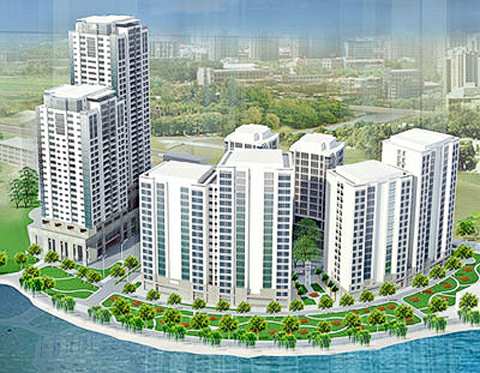Vietnam learning lessons from developed Asian real estate markets
 |
| Real estate is among the most attractive sectors to foreign investors in Vietnam. |
The information was reported at an international real estate conference entitled “Housing and Real Estate Market Development-Worldwide Experience and Options for Vietnam” held in Hanoi during November 26-28.
According to the Central Steering Committee for Housing and Real Estate Market Policy, just one third of the total number of social housing projects in Vietnam have begun construction, proving to be unattractive to investors.
Many property firms said they would make limited profits from housing projects for low-income earners because prices of apartments for them are stipulated by the state, while prices of construction materials are sharply increasing. Additionally, it is difficult for them to get loans from banks. Currently, only the Vietnam Development Bank is providing loans totaling VND7 trillion ($350 million) for social housing projects.
Experts at the conference said capital for property in Vietnam mostly come from foreign investments and people’s capital, not a specialised source. Therefore, the local market still depends on credit and monetary policies.
In the fourth quarter of 2009, a number of real estate segments saw slight changes due to lack of credit support from banks. In the third quarter of this year, the local proper market faced a standstill of transactions when banks tightened loans. This is among major causes of unstable real estate market development.
Minister of Construction, Nguyen Hong Quan, said that problems such as escalating housing and land prices against people’s income, weaknesses in site clearance and resettlement policies and undeveloped infrastructure systems connecting urban areas also have bad impacts on the Vietnamese property market.
At the gathering, Professor Stephen Mak Wing-Kai from Hong Kong Polytechnic University pointed out that preferential policies for real estate development in Hong Kong where local banks offered mortgage loans for real estate projects.
With a small area of just 1,104 km2, the Hong Kong government has applied long-term housing policies for people. In 2009, 3.3 million people in Hong Kong, or 47.1 per cent of the local population, lived in public housing, 29 per cent lived in hired apartments and 18.1 per cent in subsidised houses.
Dr. Habibullah Khan, Consultant of the World Bank, said thanks to the government’s policies, up to 82 per cent of the Singaporean population lives in public houses.
In 1960, Singapore set up the Housing Development Board to focus on building houses for low-income earners. The government also paid attention to control the realty bubble.
Meanwhile, the Japanese government concentrates on encouraging the private sector to invest in urban and infrastructure development through offering low interest or free interest loans for them.
| According to Construction Minister Nguyen Hong Quan, the national housing area has increased by 700 million square metres, including 225 million square metres in urban areas over the past 10 years. The country has over 2,500 housing, new urban areas and other real estate projects covering a combined area of 80,000 ha, including 800 in Hanoi and 1,400 in Ho Chi Minh City. Real estate is among the most attractive sectors to foreign investors in Vietnam. By late 2009, it lured in $40 billion of direct foreign investment. By the end of July this year, commercial banks in Vietnam had lent a total of VND210.77 trillion ($10.82 billion) to the real estate sector, up 14.38 per cent against late December 2009, with a bad debt ratio of below 2 per cent. |
What the stars mean:
★ Poor ★ ★ Promising ★★★ Good ★★★★ Very good ★★★★★ Exceptional
Related Contents
Latest News
More News
- Green finance offers 'passport' for Vietnamese construction, building materials firms (December 15, 2025 | 08:00)
- Gamuda Land commit long-term investment (December 12, 2025 | 11:49)
- HITC ties up with Evolution to develop AI and hyperscale data centres in Vietnam (December 11, 2025 | 12:09)
- Real estate deals boom via high-profile names (December 08, 2025 | 11:32)
- Industrial segment shaped by M&As (December 08, 2025 | 08:00)
- The Privé sets the benchmark for luxury real estate (December 05, 2025 | 08:28)
- TD CASA and the rise of bespoke interior design in luxury living spaces (December 03, 2025 | 14:14)
- Lee Soo-man's Blooming Sky to build Gia Lai culture, sport, and entertainment complex (December 02, 2025 | 16:41)
- Sustainability in DNA of Keppel Vietnam's future urban development strategy (November 28, 2025 | 10:53)
- South Korean investors seek clarity on IP lease extensions (November 24, 2025 | 17:48)

 Tag:
Tag:




















 Mobile Version
Mobile Version